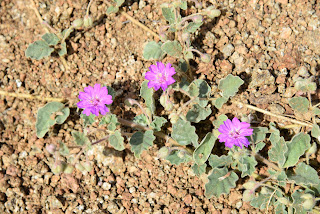MARICOPA
TRAIL: WHITE TANK-GRAND AVENUE SEGMENT
MULE DEER
TRAIL
White Tank
Mountain Regional Park
 |
| Hikers traverse a ridge on the Maricopa Trail |
Most
succinctly stated, the Maricopa Trail is a microcosm of the Valley of the Sun.
Over its
317-mile course, the non-motorized recreational trail connects 10 county parks,
wanders through open desert and farmland, tethers to suburbs and urban centers
and passes by the canals, dams and lakes that deliver water to the one of the
largest and fastest-growing areas in the Southwest.
 |
| Beautiful White Tank Mountains |
 |
| Hikers pass among ironwood trees along the Maricopa Trail |
If you
want a walking tour of the Valley’s diverse nature, this is your hike.
The
Maricopa Trail represents decades of planning, development and construction in
partnership with Maricopa County, Maricopa Board of Supervisors, Maricopa
County Parks and Recreation Department and dozens of volunteer organizations
and individuals that contribute time and resources to build and maintain the
trail. Phase 1 of the project (completion
of the Valley-circumnavigating loop) was completed earlier this year. Phase 2
will roll out this year with designs for a spur trail that will connect with the
planned 70,000-acre Vulture Mountain Regional Park in Wickenburg that’s on
track to open in 3-5 years. The trail is
a huge accomplishment that few communities across the country can match.
“I talk with many county park directors across the
country and they are envious of what we have in the Maricopa Trail,” said R.J.
Cardin Director, Maricopa County Parks and Recreation Department.
 |
| Board members of the MT + Park Foundation at MuleDeer TH |
The trail is
organized into 20 segments, each with multiple trailheads and walk-in access
points that tie together existing trails, roads and fresh-built paths.
Every
section presents a unique snapshot of every corner of the county. From the
rugged backcountry of the far north Valley that runs through Tonto National
Forest to easy water-centric strolls at Lake Pleasant and easy family favorites
like the sandy trails in San Tan Mountain Regional Park. No matter where you live in the Valley,
chances are, you’re not too far from the Maricopa Trail.
“To me,
the Maricopa Trail is a fast and easy way to escape the city and be one with
nature,” said Bill Klewer, Volunteer Coordinator, Maricopa County Parks and
Recreation Department.
“I really
appreciate that the trail can be accessed in so many locations throughout the
county.”
 |
| Kiosks similar to this one are being installed on the trail |
With so
many options, where do you start? The
county parks are a good choice for those just getting to know the trail. Well-signed and impeccably-groomed, the
sections of the trail that run through parks are low-risk, amenity-rich
gateways. One west valley segment to try
is the where the trail shares space with the Mule Deer Trail in White Tank
Mountain Regional Park in Waddell. The park map shows multiple ways to incorporate
the trail into a day hike or long-distance trek.
 |
| A scenic spot on the Mule Deer segment of the MT |
A pleasant out-and-back suggestion begins at
the Mule Deer trailhead. Head south and follow the dirt single track that
traces the park’s southeast boundary through rumpled washes and lush stands of
ironwoods and Palo verde trees that clutter moist drainages. A brief uphill climb lands hikers on a
ridgeline with vistas of patchwork grids of cotton fields and subdivisions,
agricultural flatlands and distant city high rises. All around, a fringe of mountain ranges circles
the Valley.
 |
| Far-reaching vistas are a signature feature of the MT. |
Up close, the White Tank Mountains, bolster the trail’s western edge
while the Sierra Estrella, Cave Creek and Bradshaw Mountain appear as hazy
mounds on the distant horizons.
 |
| Saguaros tower over a wash on the Maricopa Trail |
The
route drops back down to the desert floor slipping among picnic sites in an
unassuming gnarled path. At the 2.25-mile point, the trail meets a junction
where a spur path leads to the nature center, a must-see stop when visiting the
park. For a quick sampler hike, the
nature center makes for a good turn around point, unless, this snippet of a
larger entity has inspired you to tackle the entire trail. Fall through spring is the perfect time to
explore the Maricopa Trail. And with new kiosk signs designed by the nonprofit Maricopa Trail + Park Foundation and manufactured with a grant
from REI Co-op being placed at new access points across the Valley in the coming
weeks, navigating the course will be easier and more attainable than ever.
 |
| The trail traces the park's southeast edge |
 |
| The nature center at White Tank Regional Park |
 |
| The Maricopa Trail connects 10 county parks |
LENGTH: 4.5
miles out-and back as described here, 17.2 miles entire segment.
RATING:
moderate
ELEVATION: 1,506 – 1,377 feet
GETTING
THERE:
White Tank
Mountain Regional Park
20304 W.
White Tank Mountain Road, Waddell, AZ
From
Phoenix, take Interstate 10 west to the Loop 303 North exit. Go north on Loop 303 and exit at Northern
Avenue. Go left (west) at the off ramp and continue west on Northern to Cotton
Lane. Turn right (north), go 1 mile to Olive Avenue, turn left (west) and go 4
miles to the park entrance.
FEE: $7
daily fee per vehicle
FACILITIES:
restrooms, water, picnic areas, horse staging, nature center, camping (fee)
INFO:
Maricopa
Trail + Park Foundation































































